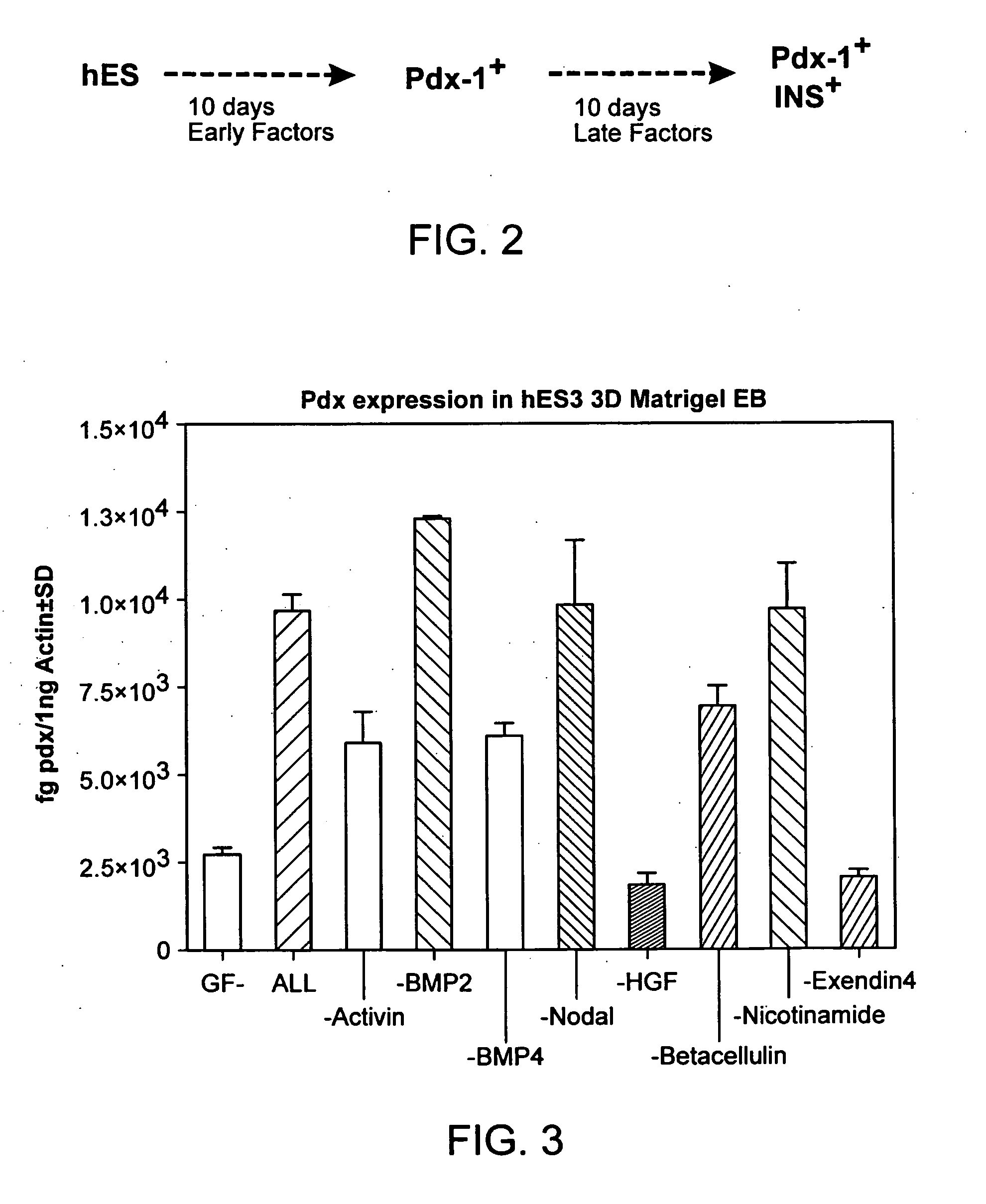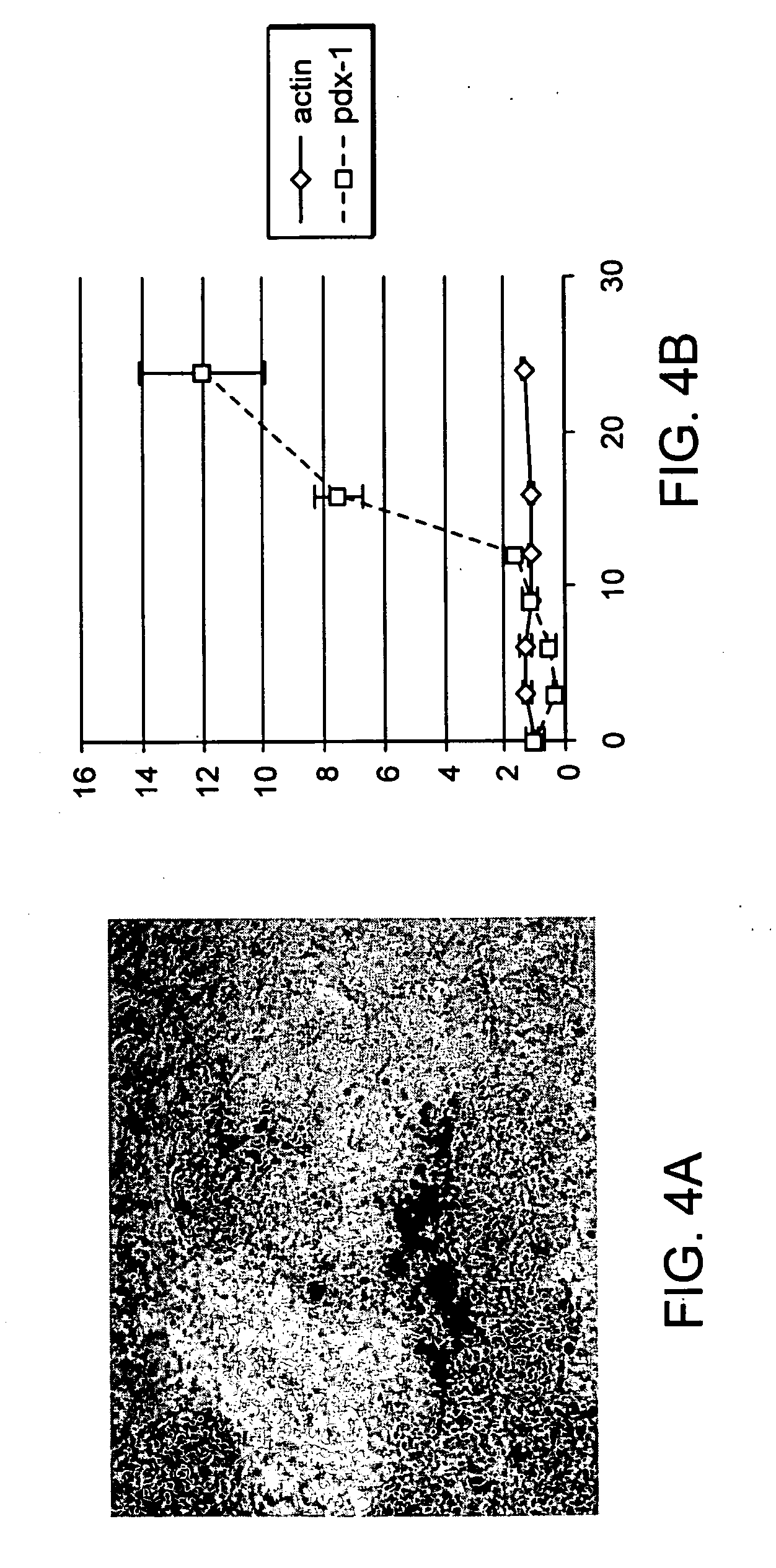Directed differentiation of embryonic stem cells and uses thereof
- Summary
- Abstract
- Description
- Claims
- Application Information
AI Technical Summary
Benefits of technology
Problems solved by technology
Method used
Image
Examples
example 1
Human Embryonic Stem Cells Spontaneously Differentiate to Ectodermal, Mesodermal, and Endodermal Cell Types
[0221]FIG. 1 confirms previous experiments demonstrating that human embryonic stem (ES) cells spontaneously differentiate along all three lineages when cultured as embryoid bodies (EBs). Human embryonic stem cell lines 1 or 2 (hES1 and hES2) were used to generate embryoid bodies. Briefly, ES cells were removed from the MEF feeder layer by either manual cutting (M) or collagenase digestion (C). The removed ES cells were then placed in appropriate media. After 0, 5, or 9 days post-EB formation, RNA was extracted from the EBs and analyzed for expression of the indicated markers by real-time RT-PCR. Relative expression shown is normalized to that of β-actin and expression for day 0 was set equal to 1. An asterisk (*) indicates arbitrary values due to no expression at day 0. Data is shown for two hES lines—hES1 and hES2, with hES2 shown in parenthesis. There was no significant chan...
example 2
Methods for Generating Embryoid Bodies
[0222] One method for directing the differentiation of stem cells is to generate embryoid bodies. These embryoid bodies can be grown under a number of conditions including, but not limited to, in floating suspension culture, in MATRIGEL™ or other matrix, or on a filter. However, the first step is the actual formation of an embryoid body from a culture of embryonic stem cells. We used any of the following methods for generating embryoid bodies from cultures of embryonic stem cells. These methods can be used to generate embryoid bodies from human embryonic stem cells grown on MEF feeder layers, embryonic stem cells grown on other feeder layers, and embryonic stem cells grown under feeder free conditions.
[0223] Materials: Human embryonic stem cells (e.g., lines hES 1-6 or DM lines); culture medium; PBS; collagenase IV stock solution (5 mg / ml)—preferably for use with hES 1-6; trypsin / EDTA stock solution (0.25%)—preferably for use with DM lines; ul...
example 3
Method for Directing the Differentiation of a Stem Cell to a Particular Differentiated Cell Type
[0240] The following is indicative of protocols that can be used to direct the differentiation of stem cells to a particular differentiated cell type. The particular protocol outlined here promoted differentiation of embryonic stem cells along the pancreatic lineage, as assayed by expression of the marker pdx-1.
[0241] Materials: Human embryonic stem cells; medium (RPMI / 20% serum replacement (20SR) / pen-strep; PBS; collagenase IV (preferably for use with hES 1-6 lines); trypsin / EDTA (preferably for DM lines); ultra-low attachment-6-well plates (Corning / costar) growth factor reduced MATRIGEL™; early factors (EF); late factors (LP).
Exemplary Time table:D-1Liquefy MATRIGEL ™ on ice and keepice box in the cold room overnight.D0-D10Early factor stageD0Make MATRIGEL ™ EB.D3Top up with RPMI / 20SR (0.5 ml) + EF(quantity for 2 ml medium).D6Top up with RPMI / 20SR (0.5 ml) + EF(quantity for 2 ml med...
PUM
| Property | Measurement | Unit |
|---|---|---|
| time | aaaaa | aaaaa |
| diameter | aaaaa | aaaaa |
| time | aaaaa | aaaaa |
Abstract
Description
Claims
Application Information
 Login to View More
Login to View More - R&D
- Intellectual Property
- Life Sciences
- Materials
- Tech Scout
- Unparalleled Data Quality
- Higher Quality Content
- 60% Fewer Hallucinations
Browse by: Latest US Patents, China's latest patents, Technical Efficacy Thesaurus, Application Domain, Technology Topic, Popular Technical Reports.
© 2025 PatSnap. All rights reserved.Legal|Privacy policy|Modern Slavery Act Transparency Statement|Sitemap|About US| Contact US: help@patsnap.com



